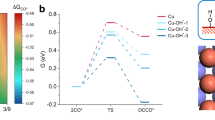Abstract
Although the electrochemical reduction of CO2 at a copper electrode produces hydrocarbons, the activity for the conversion of CO2 is significantly reduced after several tens of minutes by the deposition of poisoning species on the electrode. In order to solve the poisoning species problem, the electrochemical reduction of CO2 was carried out using a copper electrode in the pulse electrolysis mode by anodic as well as cathodic polarization. The anodic polarization intervals suppressed the deposition of the poisoning species on the electrode, and the amount of two hydrocarbons produced, CH4 and C2H6, decreased only slightly even after one hour. By choosing the appropriate anodic potential and time duration the selectivity for C2H6 formation was significantly enhanced. The enhancement was found to be due to the copper oxide formed on the copper electrode. The selectivity was further improved when the electrochemical reduction was carried out using a copper oxide electrode. The highest efficiency of about 28% was obtained at −3.15 V.








Similar content being viewed by others
References
Hori Y, Kikuchi K, Suzuki S (1985) Chem Lett 1985:1695
Hori Y, Kikuchi K, Murata A, Suzuki S (1986) Chem Lett 1986:897
Hori Y, Murata A, Takahashi R, Suzuki S (1988) J Chem Soc Chem Commun 1988:17
Hori Y, Murata A, Yoshinami Y (1991) J Chem Soc Faraday Trans 87:125
Hori Y, Wakebe H, Tsukamoto T, Koga O (1994) Electrochim Acta 39:1833
DeWuff DW, Jim T, Bard AJ (1989) J Electrochem Soc 136:1686
Wasmus S, Cattaneo E, Vielstish W (1990) Electrochim Acta 35:771
Kyriacou G, Anagnostopoulos A (1992) J Electroanal Chem 328:233
Smith BD, Irish DE, Kedzierzawski P, Aaugustynski J (1997) J Electrochem Soc 144:4288
Shiratsuchi R, Aikoh Y, Nogami G (1993) J Electrochem Soc 140:3479
Nogami G, Itagaki H, Shiratsuchi R (1996) J Electrochem Soc 143:1138
Friebe P, Bogdanoff P, Alonso-Vante N, Tributsch H (1997) J Catal 168:374
Ishimaru S, Shiratsuchi R, Nogami G (2000) J Electrochem Soc 147:1864
Shiratsuchi R, Aikoh Y, Nogami G (1993) J Electrochem Soc 140:3479
Lee J, Tak Y (2001) Electrochim Acta 46:3015
Hori Y, Konishi H, Futamura T, Murata A, Koga O, Sakurai H, Oguma K (2005) Electrochim Acta 50:5354
Nagasubramanian G, Gioda AS, Bard AJ (1981) J Electrochem Soc 128:2158
Ogura K, Sugihara H, Yano J, Higasa M (1994) J Electrochem Soc 141:419
Kita H, Kurisu T (1973) J Res Inst Hokkaido Univ 21:200
Hori Y (1996) Electrochem 64:1048
Ogura K (2003) Electrochem 71:676
Author information
Authors and Affiliations
Corresponding author
Rights and permissions
About this article
Cite this article
Yano, J., Yamasaki, S. Pulse-mode electrochemical reduction of carbon dioxide using copper and copper oxide electrodes for selective ethylene formation. J Appl Electrochem 38, 1721–1726 (2008). https://doi.org/10.1007/s10800-008-9622-3
Received:
Revised:
Accepted:
Published:
Issue Date:
DOI: https://doi.org/10.1007/s10800-008-9622-3




